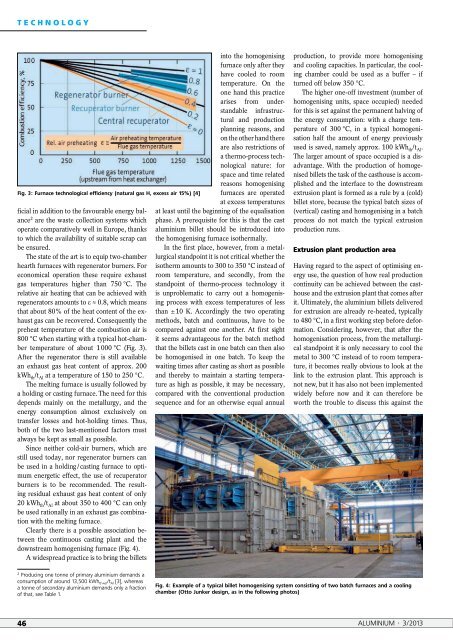special - Alu-web.de
special - Alu-web.de
special - Alu-web.de
Create successful ePaper yourself
Turn your PDF publications into a flip-book with our unique Google optimized e-Paper software.
TECHNOLOGY<br />
Fig. 3: Furnace technological efficiency (natural gas H, excess air 15%) [4]<br />
ficial in addition to the favourable energy balance<br />
2 are the waste collection systems which<br />
operate comparatively well in Europe, thanks<br />
to which the availability of suitable scrap can<br />
be ensured.<br />
The state of the art is to equip two-chamber<br />
hearth furnaces with regenerator burners. For<br />
economical operation these require exhaust<br />
gas temperatures higher than 750 °C. The<br />
relative air heating that can be achieved with<br />
regenerators amounts to ε ≈ 0.8, which means<br />
that about 80% of the heat content of the exhaust<br />
gas can be recovered. Consequently the<br />
preheat temperature of the combustion air is<br />
800 °C when starting with a typical hot-chamber<br />
temperature of about 1 000 °C (Fig. 3).<br />
After the regenerator there is still available<br />
an exhaust gas heat content of approx. 200<br />
kWh th /t Al at a temperature of 150 to 250 °C.<br />
The melting furnace is usually followed by<br />
a holding or casting furnace. The need for this<br />
<strong>de</strong>pends mainly on the metallurgy, and the<br />
energy consumption almost exclusively on<br />
transfer losses and hot-holding times. Thus,<br />
both of the two last-mentioned factors must<br />
always be kept as small as possible.<br />
Since neither cold-air burners, which are<br />
still used today, nor regenerator burners can<br />
be used in a holding / casting furnace to optimum<br />
energetic effect, the use of recuperator<br />
burners is to be recommen<strong>de</strong>d. The resulting<br />
residual exhaust gas heat content of only<br />
20 kWh th /t Al at about 350 to 400 °C can only<br />
be used rationally in an exhaust gas combination<br />
with the melting furnace.<br />
Clearly there is a possible association between<br />
the continuous casting plant and the<br />
downstream homogenising furnace (Fig. 4).<br />
A wi<strong>de</strong>spread practice is to bring the billets<br />
into the homogenising<br />
furnace only after they<br />
have cooled to room<br />
temperature. On the<br />
one hand this practice<br />
arises from un<strong>de</strong>rstandable<br />
infrastructural<br />
and production<br />
planning reasons, and<br />
on the other hand there<br />
are also restrictions of<br />
a thermo-process technological<br />
nature: for<br />
space and time related<br />
reasons homogenising<br />
furnaces are operated<br />
at excess temperatures<br />
at least until the beginning of the equalisation<br />
phase. A prerequisite for this is that the cast<br />
aluminium billet should be introduced into<br />
the homogenising furnace isothermally.<br />
In the first place, however, from a metallurgical<br />
standpoint it is not critical whether the<br />
isotherm amounts to 300 to 350 °C instead of<br />
room temperature, and secondly, from the<br />
standpoint of thermo-process technology it<br />
is unproblematic to carry out a homogenising<br />
process with excess temperatures of less<br />
than ± 10 K. Accordingly the two operating<br />
methods, batch and continuous, have to be<br />
compared against one another. At first sight<br />
it seems advantageous for the batch method<br />
that the billets cast in one batch can then also<br />
be homogenised in one batch. To keep the<br />
waiting times after casting as short as possible<br />
and thereby to maintain a starting temperature<br />
as high as possible, it may be necessary,<br />
compared with the conventional production<br />
sequence and for an otherwise equal annual<br />
production, to provi<strong>de</strong> more homogenising<br />
and cooling capacities. In particular, the cooling<br />
chamber could be used as a buffer – if<br />
turned off below 350 °C.<br />
The higher one-off investment (number of<br />
homogenising units, space occupied) nee<strong>de</strong>d<br />
for this is set against the permanent halving of<br />
the energy consumption: with a charge temperature<br />
of 300 °C, in a typical homogenisation<br />
half the amount of energy previously<br />
used is saved, namely approx. 100 kWh th /t Al .<br />
The larger amount of space occupied is a disadvantage.<br />
With the production of homogenised<br />
billets the task of the casthouse is accomplished<br />
and the interface to the downstream<br />
extrusion plant is formed as a rule by a (cold)<br />
billet store, because the typical batch sizes of<br />
(vertical) casting and homogenising in a batch<br />
process do not match the typical extrusion<br />
production runs.<br />
Extrusion plant production area<br />
Having regard to the aspect of optimising energy<br />
use, the question of how real production<br />
continuity can be achieved between the casthouse<br />
and the extrusion plant that comes after<br />
it. Ultimately, the aluminium billets <strong>de</strong>livered<br />
for extrusion are already re-heated, typically<br />
to 480 °C, in a first working step before <strong>de</strong>formation.<br />
Consi<strong>de</strong>ring, however, that after the<br />
homogenisation process, from the metallurgical<br />
standpoint it is only necessary to cool the<br />
metal to 300 °C instead of to room temperature,<br />
it becomes really obvious to look at the<br />
link to the extrusion plant. This approach is<br />
not new, but it has also not been implemented<br />
wi<strong>de</strong>ly before now and it can therefore be<br />
worth the trouble to discuss this against the<br />
2<br />
Producing one tonne of primary aluminium <strong>de</strong>mands a<br />
consumption of around 13,500 kWh th+el /t Al [3], whereas<br />
a tonne of secondary aluminium <strong>de</strong>mands only a fraction<br />
of that, see Table 1.<br />
Fig. 4: Example of a typical billet homogenising system consisting of two batch furnaces and a cooling<br />
chamber (Otto Junker <strong>de</strong>sign, as in the following photos)<br />
46 ALUMINIUM · 3/2013
















